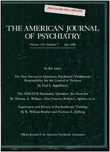Social class and psychiatric practice: a revision of the Hollingshead and Redlich model
Abstract
In 1958, Hollingshead and Redlich demonstrated that there were major differences in mental health care for lower-class patients: they primarily received low-intervention treatments from nonprofessional staff. The authors report a follow-up study initiated by F.C. Redlich that reveals new trends at the community mental health center (CMHC) serving the region studied by Hollingshead and Redlich. More than half of the lower-class patients who sought evaluation at this CMHC were discharged without a treatment assignment. Many lower-class patients, however, gained access to the CMHC's psychotherapy unit. Most of these patients were women, employed, and diagnosed as psychoneurotic. The authors conclude that the effect of social class on psychiatric care is less complete than Hollingshead and Redlich originally demonstrated.
Access content
To read the fulltext, please use one of the options below to sign in or purchase access.- Personal login
- Institutional Login
- Sign in via OpenAthens
- Register for access
-
Please login/register if you wish to pair your device and check access availability.
Not a subscriber?
PsychiatryOnline subscription options offer access to the DSM-5 library, books, journals, CME, and patient resources. This all-in-one virtual library provides psychiatrists and mental health professionals with key resources for diagnosis, treatment, research, and professional development.
Need more help? PsychiatryOnline Customer Service may be reached by emailing [email protected] or by calling 800-368-5777 (in the U.S.) or 703-907-7322 (outside the U.S.).



